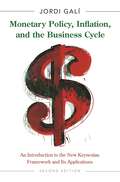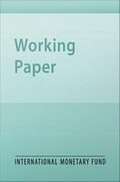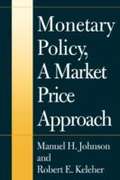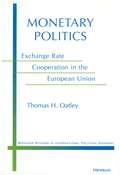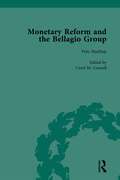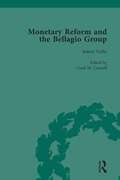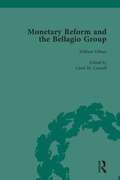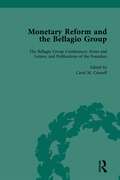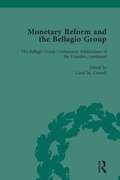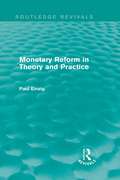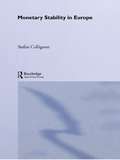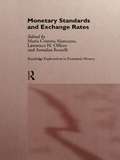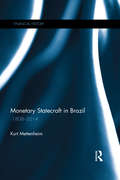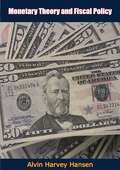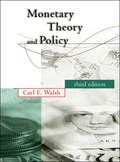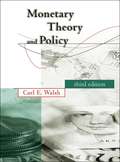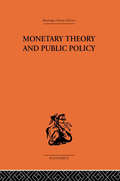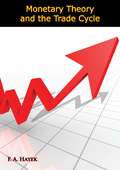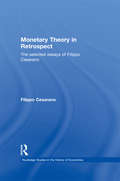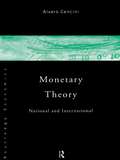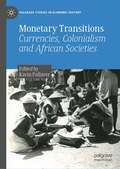- Table View
- List View
Monetary Policy, Inflation, and the Business Cycle: An Introduction to the New Keynesian Framework and Its Applications - Second Edition
by Jordi GalíThe classic introduction to the New Keynesian economic modelThis revised second edition of Monetary Policy, Inflation, and the Business Cycle provides a rigorous graduate-level introduction to the New Keynesian framework and its applications to monetary policy. The New Keynesian framework is the workhorse for the analysis of monetary policy and its implications for inflation, economic fluctuations, and welfare. A backbone of the new generation of medium-scale models under development at major central banks and international policy institutions, the framework provides the theoretical underpinnings for the price stability–oriented strategies adopted by most central banks in the industrialized world.Using a canonical version of the New Keynesian model as a reference, Jordi Galí explores various issues pertaining to monetary policy's design, including optimal monetary policy and the desirability of simple policy rules. He analyzes several extensions of the baseline model, allowing for cost-push shocks, nominal wage rigidities, and open economy factors. In each case, the effects on monetary policy are addressed, with emphasis on the desirability of inflation-targeting policies. New material includes the zero lower bound on nominal interest rates and an analysis of unemployment’s significance for monetary policy.The most up-to-date introduction to the New Keynesian framework availableA single benchmark model used throughoutNew materials and exercises includedAn ideal resource for graduate students, researchers, and market analysts
Monetary Policy, Leverage, and Bank Risk Taking
by Giovanni Dell'Ariccia Luc Laeven Robert MarquezA report from the International Monetary Fund.
Monetary Policy: A Market Price Approach
by Manuel H. Johnson Robert E. KeleherThis is a comprehensive presentation of how monetary policymakers can use market prices to produce price stability. Drs. Johnson and Keleher show why other conventional methods have failed and why market prices are superior guides for setting monetary policy. Their book presents the rationale, history, and philosophy underlying their approach; offers three forms of empirical research evidence to support it; and presents special methods to use market prices as policy setting guides.
Monetary Politics: Exchange Rate Cooperation in the European Union
by Thomas H. OatleyThis is the first book to describe and analyze the relationships between the Federal Reserve and the president, Congress, bankers, and economists. Far from being politically independent, the Federal Reserve is shown to be sensitive to a wide range of political influences.
Monetary Reform and the Bellagio Group Vol 1: Selected Letters and Papers of Fritz Machlup, Robert Triffin and William Fellner
by Carol M Connell Joseph SalernoThe Bellagio Group was founded at a time of global economic crisis. This collection brings together the private correspondence and published papers of the Group’s founders, creating a picture of the personalities, issues, debates and compromises leading to the adoption of flexible exchange rates and a modified Triffin plan.
Monetary Reform and the Bellagio Group Vol 2: Selected Letters and Papers of Fritz Machlup, Robert Triffin and William Fellner
by Carol M Connell Joseph SalernoThe Bellagio Group was founded at a time of global economic crisis. This collection brings together the private correspondence and published papers of the Group’s founders, creating a picture of the personalities, issues, debates and compromises leading to the adoption of flexible exchange rates and a modified Triffin plan.
Monetary Reform and the Bellagio Group Vol 3: Selected Letters and Papers of Fritz Machlup, Robert Triffin and William Fellner
by Carol M Connell Joseph SalernoThe Bellagio Group was founded at a time of global economic crisis. This collection brings together the private correspondence and published papers of the Group’s founders, creating a picture of the personalities, issues, debates and compromises leading to the adoption of flexible exchange rates and a modified Triffin plan.
Monetary Reform and the Bellagio Group Vol 4: Selected Letters and Papers of Fritz Machlup, Robert Triffin and William Fellner
by Carol M Connell Joseph SalernoThe Bellagio Group was founded at a time of global economic crisis. This collection brings together the private correspondence and published papers of the Group’s founders, creating a picture of the personalities, issues, debates and compromises leading to the adoption of flexible exchange rates and a modified Triffin plan.
Monetary Reform and the Bellagio Group Vol 5: Selected Letters and Papers of Fritz Machlup, Robert Triffin and William Fellner
by Carol M Connell Joseph SalernoThe Bellagio Group was founded at a time of global economic crisis. This collection brings together the private correspondence and published papers of the Group’s founders, creating a picture of the personalities, issues, debates and compromises leading to the adoption of flexible exchange rates and a modified Triffin plan.
Monetary Reform in Theory and Practice (Routledge Revivals)
by Paul EinzigFirst published in 1936, this book gives the reader an insight into the tendencies and spirit of the monetary reform movement as a whole, as accomplished or proposed since the First World War. The author marks the consideration of the overall reform as being more important than specifically looking at the actual proposals and measures involved, and the views he attributes to the various monetary reform schools are therefore composite views of the various factions of those schools. As a comparatively recent convert to the idea of monetary reform, at the time of writing, the author offers a balanced view of the subject as he also has extensive experience of the ideas of the orthodox monetary system. However, he does not believe that monetary reform alone can achieve the desired end without considerable economic planning. Indeed, he suggests that the monetary reform movement he discusses desperately needs to adopt a broader perspective and thus, he suggests a compromise.
Monetary Stability in Europe (Routledge International Studies in Money and Banking #Vol. 16)
by Stefan CollignonIn this book, the author presents fresh perspectives on the theories surrounding European Monetary Union. Urging the reader to examine conventional ideas from new viewpoints, he discusses the events which led to EMU, analyses the current situation, and projects possible futures.Essential reading for academics and professionals concerned with the background and implications of EMU, this book will also be of considerable interest to scholars in the fields of European studies, monetary economics, international economics and economic history.
Monetary Standards and Exchange Rates (Routledge Explorations in Economic History)
by Maria Cristina Marcuzzo Annalisa Rosselli Lawrence H. OfficerIn this volume an international team of distinguished monetary historians examine the historical experience of exchange rate behaviour under different monetary regimes. The main focus is on metallic standards and fixed exchange rates, such as the gold standard. With its combination of thematic overviews and case studies of the key countries and periods, the book greatly enhances our understanding of past monetary systems.
Monetary Statecraft in Brazil: 1808–2014 (Financial History)
by Kurt MettenheimBrazil has one of the world's fastest growing economies and a fascinating history underpinning its evolution. This book presents an analysis of the state's role in monetary policy, from the latter days of Portuguese rule, to the present day. Based on a variety of unknown archival sources, this study offers an alternative explanation for the rise and fall of Brazilian currencies. Monetary statecraft is a theory that accounts for the open ended, autonomous character of politics, the complex, recursive phases of public policy, and political development in the traditional sense of social inclusion. Unfortunately, there are few precedents for this type of analysis. This book fills this gap by tracing how Brazilian policy makers and observers have sought, experimented with, and reflected on a variety of forms and solutions for monetary policy since 1808. This book will be of interest to economists, financial historians and those interested in the history and economy of Brazil.
Monetary Theory and Fiscal Policy
by Alvin Harvey HansenIN TRADITIONAL economics the theory of money and the theory of output have been treated separately with little or no tendency toward integration. First Wicksell and then Keynes gave impetus to the movement to combine the theory of money with that of output as a whole. Drawing on classical economics and the modern aggregate analysis of Keynes, Professor Hansen in this volume succeeds in writing a book which, unlike the classical studies, shows the importance of money in the theory of output as a whole; and which, unlike numerous modern writings (e.g., of Hawtrey, Douglas, Hayek), avoids overemphasizing the importance of money. Here is a book that shows what monetary policy can and cannot achieve and why it has often failed in the past; the necessary supplementary role of monetary policy as an aid to fiscal policy; and the manner of integrating monetary and fiscal policy, in periods of both depression and inflation, as prerequisites for assuring a stable economy.Professor Hansen has drawn on his rich experience over thirty-five years in the study of cycles, fiscal policy, and international economics, and on his many years as an economic practitioner to write a book that makes use of the riches of classical economics, as well as neoclassical and Keynesian economics. The book should, for many years to come, be the standard work on monetary theory and fiscal policy as determinants of output. The reader will find here not only the modern theory of money and fiscal policy, but also rich surveys covering the last 150 years, reinterpreted with the tools of modern economics. He will find also suggestions, based on theory and history, for a policy in the years to come that will yield the high levels of income and stability without which the survival of democratic institutions is most unlikely.
Monetary Theory and Policy from Hume and Smith to Wicksell
by Arie ArnonThis book provides a comprehensive survey of the major developments in monetary theory and policy from David Hume and Adam Smith to Walter Bagehot and Knut Wicksell. In particular, it seeks to explain why it took so long for a theory of central banking to penetrate mainstream thought. It investigates how major monetary theorists understood the roles of the invisible and visible hands in money, credit and banking; what they thought about rules and discretion and the role played by commodity-money in their conceptualizations; whether or not they distinguished between the two different roles carried out via the financial system; how they perceived the influence of the monetary system on macroeconomic aggregates such as the price level, output and accumulation of wealth; and finally, what they thought about monetary policy. It also explores the analytical dimensions in the various monetary theories while emphasizing their policy consequences.
Monetary Theory and Policy, third edition (The\mit Press Ser.)
by Carl E. WalshA new edition of the leading text in monetary economics, a comprehensive treatment revised and enhanced with new material reflecting recent advances in the field.This text presents a comprehensive treatment of the most important topics in monetary economics, focusing on the primary models monetary economists have employed to address topics in theory and policy. It covers the basic theoretical approaches, shows how to do simulation work with the models, and discusses the full range of frictions that economists have studied to understand the impacts of monetary policy. Among the topics presented are money-in-the-utility function, cash-in-advance, and search models of money; informational, portfolio, and nominal rigidities; credit frictions; the open economy; and issues of monetary policy, including discretion and commitment, policy analysis in new Keynesian models, and monetary operating procedures. The use of models based on dynamic optimization and nominal rigidities in consistent general equilibrium frameworks, relatively new when introduced to students in the first edition of this popular text, has since become the method of choice of monetary policy analysis.This third edition reflects the latest advances in the field, incorporating new or expanded material on such topics as monetary search equilibria, sticky information, adaptive learning, state-contingent pricing models, and channel systems for implementing monetary policy. Much of the material on policy analysis has been reorganized to reflect the dominance of the new Keynesian approach. Monetary Theory and Policy continues to be the only comprehensive and up-to-date treatment of monetary economics, not only the leading text in the field but also the standard reference for academics and central bank researchers.
Monetary Theory and Policy: Third Edition
by Carl E. WalshThis text presents a comprehensive treatment of the most important topics in monetary economics, focusing on the primary models monetary economists have employed to address topics in theory and policy. It covers the basic theoretical approaches, shows how to do simulation work with the models, and discusses the full range of frictions that economists have studied to understand the impacts of monetary policy. Among the topics presented are money-in-the-utility function, cash-in-advance, and search models of money; informational, portfolio, and nominal rigidities; credit frictions; the open economy; and issues of monetary policy, including discretion and commitment, policy analysis in new Keynesian models, and monetary operating procedures. The use of models based on dynamic optimization and nominal rigidities in consistent general equilibrium frameworks, relatively new when introduced to students in the first edition of this popular text, has since become the method of choice of monetary policy analysis. This third edition reflects the latest advances in the field, incorporating new or expanded material on such topics as monetary search equilibria, sticky information, adaptive learning, state-contingent pricing models, and channel systems for implementing monetary policy. Much of the material on policy analysis has been reorganized to reflect the dominance of the new Keynesian approach. Monetary Theory and Policy continues to be the only comprehensive and up-to-date treatment of monetary economics, not only the leading text in the field but also the standard reference for academics and central bank researchers.
Monetary Theory and Public Policy
by Kenneth K. KuriharaProviding an extensive examination of monetary theory and its implications for public policy, Monetary Theory and Public Policy is as relevant for an understanding of current economic problems as when it was first published. Looking at the concepts of modern economic theory, particularly as these concepts apply to problems of money and banking, both Keynesian and Post-Keynesian developments are discussed.
Monetary Theory and the Trade Cycle
by F. A. HayekPublished originally in 1929, Monetary Theory and the Trade Cycle is the first essay Friedrich A. Hayek wrote. It serves as a primer into Hayek's monetary and capital theories.
Monetary Theory in Retrospect: The Selected Essays of Filippo Cesarano (Routledge Studies in the History of Economics #92)
by Filippo CesaranoAn objective and perceptive account of the literature of monetary theory, this volume, by a central banker who has studied monetary theory over the last quarter of a century, clearly shows how its inherent complexity is much enriched by the study of its history. In three parts Filippo Cesarano: focuses on the innovative ideas of distinguished economists who anticipated modern theories, elaborating on them along lines that suggest original research programmes examines the impact of expectations on the effectiveness of monetary policy, illustrating how different assumptions within the classical paradigm lead to diverse hypotheses and policy design investigates the role of monetary theory in shaping monetary institutions. Deserving of a wide readership among both academic economists and monetary policy practitioners, this collection of essays is key reading for students and researchers engaged with monetary theory and the history of economics and policy makers seeking to weigh up the assumptions underlying different theories in order to select the models best suited to the problems they face.
Monetary Theory: National and International
by Alvaro CenciniMonetary Theory provides an alternative to monetary economics based on the distinctive properties of money banking. The book: *Analyses money *Shows that the distinction between money and income is rooted in the banking practice *Examines exchange rate instability and financial crisis *Puts forward an alternative proposal for European Monetary Union.
Monetary Transitions: Currencies, Colonialism and African Societies (Palgrave Studies in Economic History)
by Karin PallaverThis book uses money as a lens through which to analyze the social and economic impact of colonialism on African societies and institutions. It is the first book to address the monetary history of the colonial period in a comprehensive way, covering several areas of the continent and different periods, with the ultimate aim of understanding the long-term impact of colonial monetary policies on African societies. While grounding an understanding of money in terms of its circulation, acceptance and impact, this book shows first and foremost how the monetary systems that resulted from the imposition of colonial rule on African societies were not a replacement of the old currency systems with entirely new ones, but were rather the result of the convergence of different orders of value and monetary practices. By putting histories of people using money at the heart of the story, and connecting them to larger imperial policies, the volume provides a new and fresh perspective on the history of the establishment of colonial rule in Africa. This book is the result of a collaborative and interdisciplinary research project that has received funding by the Gerda Henkel Foundation. The contributors are both junior and senior scholars, based at universities in Europe, Africa, Asia and the US, who are all specialists on the history of money in Africa. It will appeal to an international audience of scholars and educators interested in African Studies and History, Economic History, Imperial and Colonial History, Development Studies, Monetary Studies.
Monetary Transmission in an Emerging Targeter: The Case of Brazil
by Luis Catão Douglas Laxton Adrian PaganA report from the International Monetary Fund.
Monetary Union Among Member Countries of the Gulf Cooperation Council
by John Wilson Rina Bhattacharya Andrea Schaechter Van Can Thai Bright OkoguThe six member countries of the Gulf Cooperation Council (GCC)--Bahrain, Kuwait, Oman, Qatar, Saudi Arabia, and the United Arab Emirates--have made important progress toward economic and financial integration, with the aim of establishing an economic and monetary union. This paper provides a detailed analysis of the economic performance and policies of the GCC countries during 1990-2002. Drawing on the lessons from the experience of selected currency and monetary unions in Africa, Europe, and the Caribbean, it assesses the potential costs and benefits of a common currency for GCC countries and also reviews the options for implementing a monetary union among these countries.
Monetary Union in West Africa (ECOWAS)
by Paul R. Masson Catherine A. PattilloIn April 2000 six West African countries declared their intention to proceed to monetary union among the non-CFA franc countries of the region by January 2003, as a first step toward a wider monetary union including all the ECOWAS countries in 2004. The purpose of this paper is to evaluate whether a monetary union makes economic sense, to discuss the institutional requirements for successful monetary union and to consider how best the political momentum for a union can be channeled toward a fundamental improvement in underlying policies.
